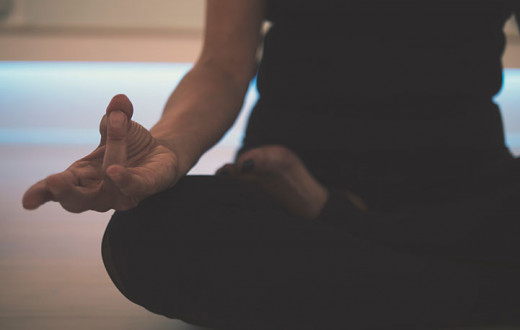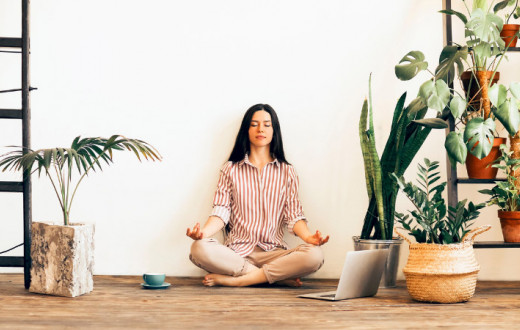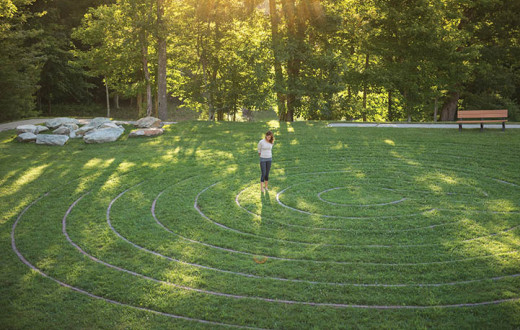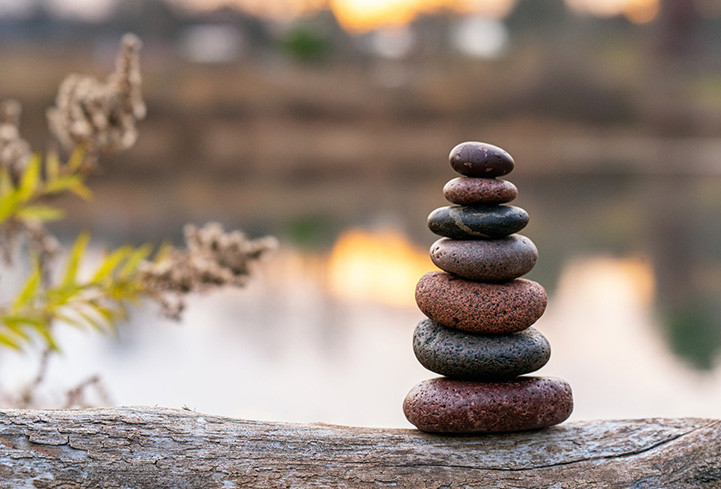
Imagine that your body has a circuit network. In the physical body, this circuit network is made up of arteries, veins, nerves, and the organs they are connected to.
According to the yogis of ancient times, in addition to the circuit network in the physical body, there is a subtle body, or energy body, that you can’t see or touch. This is where all the life-force energy flows. The circuit network in the subtle body is made up of chakras (energy centers) and channels.
Topics covered:
- What are chakras, and why are they important?
- The 7 Chakras: Symbols, symptoms, and effects
- Chakra infographic
- How to tell if your chakras are stuck
- How to balance your chakras: Beginner's guide to chakra meditation and affirmations
- The connection between yoga and chakras: Balancing your energy centers
- The science behind chakras: How they influence your health and well-being
What are chakras, and why are they important?
One part of this ancient philosophy is Kundalini energy. Kunda means ‘pot’ in Sanskrit (the ancient language of yoga). The body is like a pot, and the energy in the body is called the kundalini shakti (kundalini energy). In ancient times, artists portrayed this subtle energy as a coiled serpent. The coiled serpent conveys the resting or dormant state of the kundalini shakti. It sits at the base of your spine, at your root chakra.
When this energy is awakened and rises, life becomes more and more of a celebration. The entire world appears more beautiful and wonderful when the power of consciousness gets awakened within you.
What is the chakra system?
Before we go any further, what does “chakra” mean? Chakra is a Sanskrit word meaning wheel or circular. The chakras correspond to the nerve centers or nerve plexuses in the physical body; a chakra is simply an energy center or reservoir. It is believed that the human body actually has 109 total chakras, but seven energy centers are of primary importance. These are the seven main chakras you’ve likely heard of.
All these energy centers are connected through channels, subtle energy pathways through which life force energy flows freely. It is similar to how roads meet at an intersection with cars flowing in and out. You can think of chakras as the intersection (the convergence point), while the channels are the roads, and the life-force energy is the cars.
Why are chakras important?
When the subtle lifeforce energy isn’t flowing properly, your physical health can deteriorate while also having a negative impact on your mental health.
This can feel like your chakras are blocked, though it is really the downward flow of the energy. The good news is that you can influence the flow of energy to improve your overall health. Keep reading to learn more.
How do chakras affect your health and well-being?
Whenever you are experiencing health issues or a negative mindset, there are things you can do to generate an upward movement of this energy and begin to feel better. Here’s a list of what to do and what not to do in order to facilitate the energy flow in an upward direction.
Do this to reverse a downward flow of energy and encourage an upward flow of energy
☐ Avoid eating meats, canned, processed, or leftover foods.
☐ Eat more high prana foods like fresh fruits and vegetables, especially sprouted foods and hard shell squashes.
☐ Avoid watching too much TV or playing video games for an extended period of time.
☐ Attend live musical or inspirational performances.
☐ Don’t oversleep, but also be sure to get enough sleep.
☐ Spend time in nature and in silence.
☐ Meditate and practice breathing exercises like bellows breath and bee breath.
The 7 Chakras: Location, colors, symbols, and effects
The ancient sages described each of the seven chakras as a lotus or different flowers. This is because when you go deeper in meditation, the consciousness becomes very subtle, alive, and fresh, like a flower. In such a delicate state of consciousness, you experience the rise of energy in the system. Lightness is connected with subtlety and positive expressions. Grossness is connected with inertia and negative sensations. Let’s look at the subtleties and gross expressions of the seven chakras.
1. Muladhara Chakra – Root Chakra
Location: Base of the spine
Associated color: Red
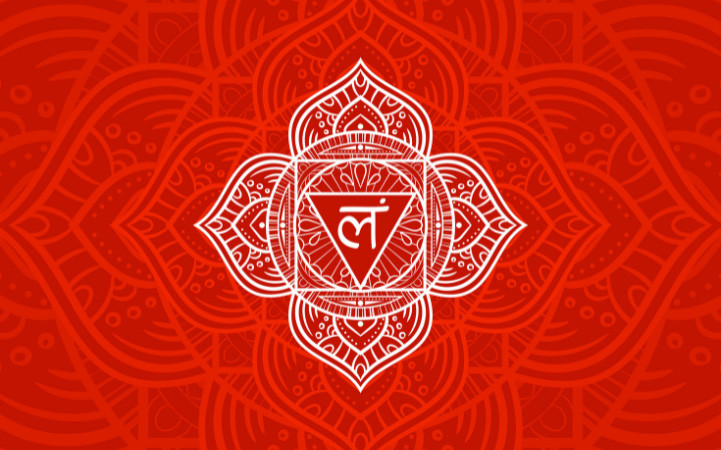
Symbol: The root chakra is depicted with a four-petaled lotus flower representing the elements: earth, water, fire, and air. In the center of the lotus, there is a square and an inverted triangle, the foundation and the root, which connects us to the earth.
Keyword: Enthusiasm
Element: Earth
Upward effects: When you have a balanced root chakra, and the energy is flowing upward, you experience a feeling of enthusiasm, dynamism, and liveliness. This energy supports and enlivens our lives.
Downward effects: When the energy is moving downward toward the root chakra, we feel inertia, dullness, and stuck. Without enthusiasm, life can become meaningless, boring, and stagnant. Physical symptoms could include constipation and illnesses that result in little to no energy, while mental symptoms are connected to depression and insecurity.
2. Svadhishthana Chakra – Sacral Chakra
Location: Behind the genitals
Associated color: Orange
Keyword: Creativity
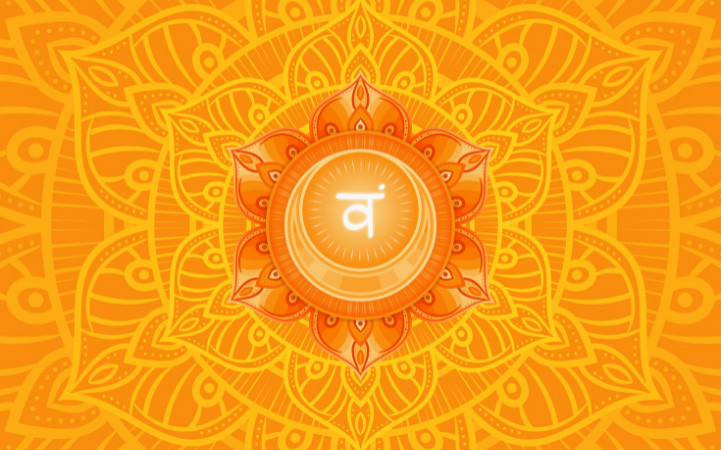
Symbol: The symbol for the sacral chakra is a six-petalled lotus representing the cycles of birth, death, and rebirth. The crescent moon in the center reminds us of the connection we have with the moon and its influence on the water element.
Element: The sacral chakra is connected with the water element. The maximum amount of water resides around the sacral chakra in the bladder region.
Upward effects: When the life-force energy moves upwards to the second chakra, it manifests as procreation, creative energy, and sexual energy. You can kindle this energy through art, writing, dancing, or other forms of creative expression.
Downward effects: When energy flows downwards, this is reversed. You may feel uncreative, uninspired, and don’t feel like doing much of anything. This can flip into lust and an obsession with sex. Physical symptoms could include infections in the bladder or reproductive organs.
3. Manipura Chakra – Solar Plexus Chakra
Location: Navel region
Associated color: Yellow
Keyword: Giving
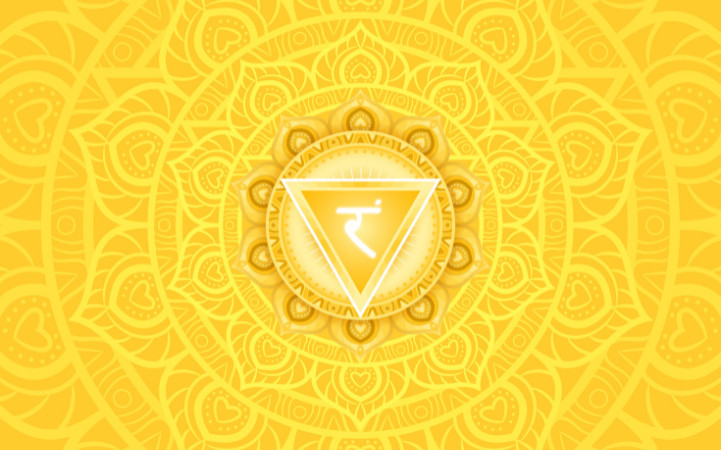
Symbol: The solar plexus chakra energy is depicted by a ten-petaled flower representing the ten pranas that converge in the naval region.
Element: The solar plexus chakra is connected with the fire element. The digestive fire present in the belly region here helps with digestion.
Upward effects: When the energy is flowing upwards through the Manipura chakra, it manifests as joy and generosity. Generosity and joy are often symbolized as having a big belly. Santa Claus and the Laughing Buddha— they both have big bellies!
Downward effects: The same energy moves downwards to the solar plexus chakra in the navel region and manifests in jealousy or greed. When people feel jealous, they feel some sensation in the stomach region. Issues on the physical level could include the inability to break down food properly and other digestive imbalances.
4. Anahata Chakra – Heart Chakra
Location: Heart or chest region
Associated color: Green
Keyword: Love
Element: The heart chakra is the fourth chakra and is connected with the air element. The greatest proportion of air in the body is in the lungs, in the chest region around the Anahata chakra.
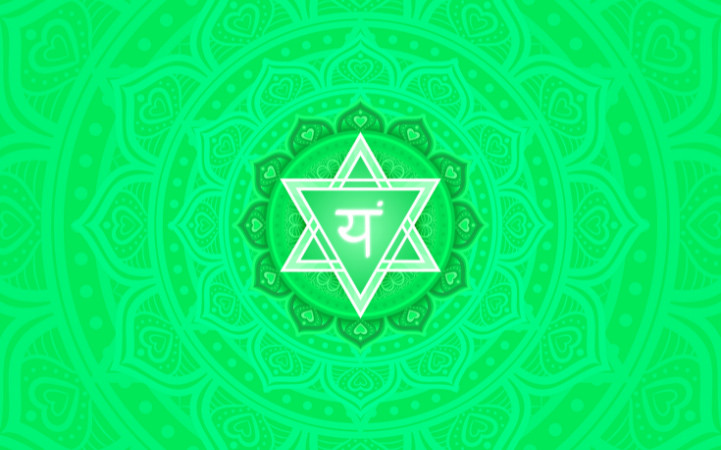
Symbol: Artists depict the heart chakra as having twelve petals. Though traditions vary in their interpretation of these twelve petals, all stem from either love, fear, or hate.
Upward effects: From the navel region, the energy moves upwards to the heart chakra, where it manifests as love.
Downward effects: When energy flows downward, it manifests as fear or hate. Issues affecting the mind and body could include not being able to recover from a broken heart.
When there is love, there is no fear. When there is fear, there is no love.
5. Vishuddha Chakra – Throat Chakra
Location: Throat region
Associated color: Blue
Keyword: Gratitude
Element: The throat chakra is connected with the space or ether element.
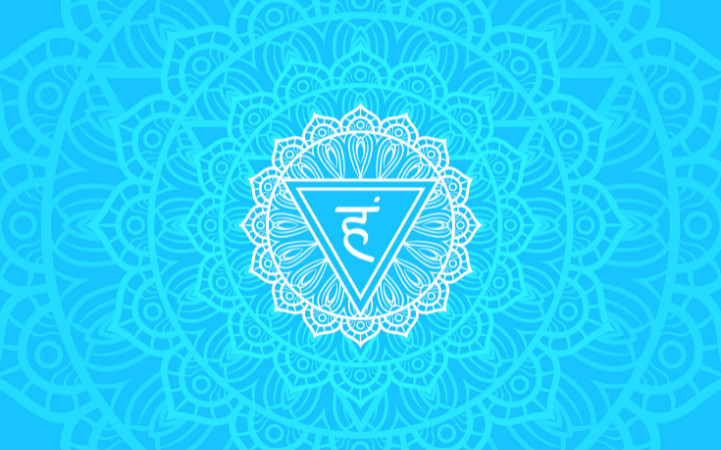
Symbol: For the throat chakra, sixteen petals are present, often marked with the sixteen vowels of the Sanskrit language.
Upward effects: When the energy in the fifth chakra flows upward to the throat region, it manifests as gratitude. When you feel very grateful, you may notice that your throat chokes.
Downward effects: When this energy is flowing downwards, you can experience depression and feeling stuck in grief.
6. Ajna Chakra – Third Eye Chakra
Location: Between the eyebrows
Associated color: Indigo
Keyword: Aware
Element: The third eye chakra is connected to the light element.
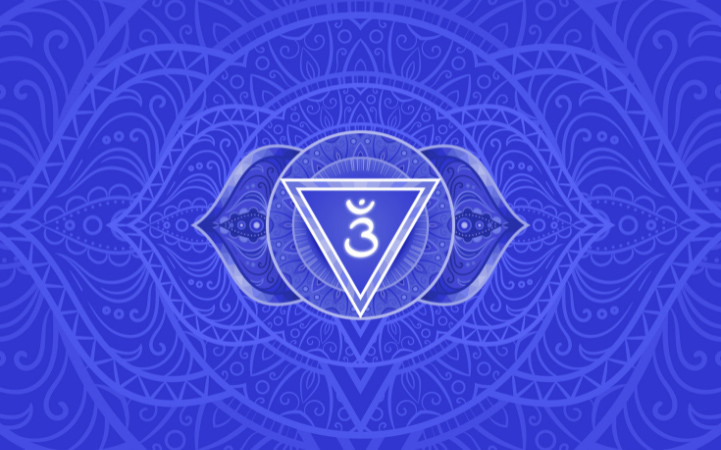
Symbol: The third eye chakra symbol has two petals with an upside-down triangle representing wisdom and enlightenment.
Upward effects: When the energy moves up to the center of the forehead, to the third chakra between the eyebrows, it manifests as awareness or alertness.
Downward effects: When the energy flows downward, the energy manifests as anger. Too much anger can lead to a long list of physical ailments, including high blood pressure, cancer, and depression.
7. Sahasrara Chakra – Crown Chakra
Location: Top of the head
Associated colors: White and purple
Keyword: Joy
Element: The crown chakra is connected with universal energy.
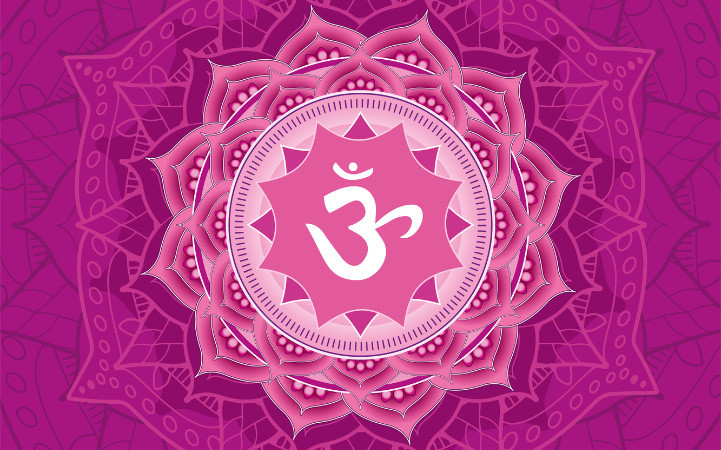
Symbol: This particular chakra is the highest chakra and is represented by a lotus flower with 1,000 petals (Sahasrara is a poetic reference to a thousand-petal lotus). It is said that the bliss of deep samadhi meditation is a thousand times the bliss of sex.
Upward effects: When the life force energy flows to the seventh chakra, to the crown chakra, you experience greater joy in life. When firmly established there, duality, conflict, and separation fade. You feel totally connected and one with everything, experiencing divine consciousness.
Downward effects: The crown chakra has no downward manifestations.
How to tell if your chakras are stuck
If you’re feeling intense negative emotions like lust, jealousy, fear, grief, and anger, then your corresponding chakra is experiencing a downward flow. And you could be stuck in that downward direction for an extended period of time if you don’t do something proactive from the list above.
How to balance your chakras: Beginner's guide to chakra meditation and affirmations
While there is a lot of talk about chakra balancing, opening, or even activating the chakras, in traditional yogic philosophy, the focus is more on how your life energy flows up and down through the chakras.
The upward energy flow
When the energy moves upward through the different chakras, from the base of the spine to the crown chakra at the top of the head, this is a positive, upward movement. When the energy is moving up, you experience enthusiasm, creativity blossoms, and there is generosity and contentment, which in turn give rise to love. Love takes you to gratitude, which helps to bring awareness and wisdom and ultimately leads you to joy. Your personal power and potential blossom. Your spiritual energy grows.
The downward spiral
However, when the energy flows in the opposite direction, it is a different story. Joy fades, and we may experience anger. And from anger springs hatred and aversion. This leads to a sense of fear. Fear gives rise to jealousy and envy, which in turn can give rise to lust, feverishness, or obsession. And lust and obsession can trap us in inertia and negativity.
Chakra meditation
This upward or downward flow happens very naturally and spontaneously all the time. When we practice yoga and meditation while maintaining a healthy diet and lifestyle, we can encourage the upward flow of energy and enjoy its many benefits.
More than trying to open or balance the chakras, the important thing is cultivating the upward flow. You can do this through meditation, breathing exercises, and yoga postures. This way, we invoke all the positive and enjoyable qualities of each energy center.
Enjoy this chakra meditation to help balance your energy and experience the chakras. In this guided meditation, Gurudev Sri Sri Ravi Shankar gives a simple explanation of how energy moves through the seven chakras and what emotions you may experience with the flow of the energy.
If you are looking for even more guided chakra meditations, click here for a FREE 7-day on-demand chakra meditation program.
Affirmations for energy healing
1. Root Chakra- I am thriving.
2. Sacral Chakra- I am creative.
3. Solar Plexus Chakra- I am abundant.
4. Heart Chakra- I am loving.
5. Throat Chakra- I am grateful.
6. Third Eye Chakra- I am aware.
7. Crown Chakra- I am joy.
The connection between yoga and chakras: Balancing your energy centers
Understanding the chakras through the lens of yoga
According to yoga, you are so much more than just your physical body.
You also have a subtle, energetic body. This energetic body is made up of subtle energy pathways through which the life force flows. There are certain points in the body where these energy pathways converge, and you guessed it, these energy centers are called chakras.
Ideally, this powerful energy primarily flows in an upward direction. When this happens, you experience the positive aspects of each chakra. When the energy flows in the opposite direction, you experience the negative qualities of each chakra.
Balancing the chakras with yoga
Here is a list of yoga poses you can use to balance all the chakras. A regular yoga practice that includes these yoga poses will facilitate an upward energy flow.
Muladhara (Root Chakra)
Svadhisthana (Sacral Chakra)
- Butterfly pose
- Side angle pose
- Garland pose
Manipura (Solar Plexus Chakra)
- Boat pose
- Reverse plank
- Sun Salutations (good for encouraging energy to flow upwards, benefitting all chakras)
Anahata (Heart Chakra)
Vishuddha (Throat Chakra)
- Shoulder stand
- Wheel pose
- Seated Cat-Cow
- Easy pose (sitting cross-legged) with chanting
Anja (Third-Eye Chakra)
- Pigeon pose
- Dolphin pose
- Lotus pose with chanting
Sahasrara (Crown Chakra)
Balancing butterfly pose
Savasana (corpse pose after yoga or meditation)
Lotus pose with chanting
You can join a yoga class here.
Here’s an excellent chanting session you can use for chakra balancing.
Om Namah Shivaya Powerful Healing Mantra Guided Meditation By Gurudev Sri Sri Ravi Shankar
The science behind chakras: How they influence your health and well-being
How does science see chakras, and how do they work?
According to quantum physics and scientific research, EVERYTHING IS ENERGY. The movement of energy is considered a core principle on which many healing traditions are based. In addition to yoga, many ancient practices such as Reiki, QiGong, and Tai Chi focus on the proper functioning of the energy system to achieve health and well-being.
The connection between chakras and your nervous system
These seven chakras, or seven nerve centers, are connected with different glands in the body—the thyroid gland, the adrenaline glands, the pituitary gland, the pineal gland, and so on. Science is also exploring how these glands are connected with the experience of different emotions. This is something the ancient sages saw thousands of years ago.
The benefits of balancing your chakras
When you naturally balance your chakras through meditation, breathwork, and yoga, you will reap all kinds of benefits, leading to an optimal life in body, mind, and spirit. Emotional blockages will give way to enthusiasm, creativity, joy, generosity, love, gratitude, awareness, and divine consciousness. Your overall physical health will also improve.
How to clear stuck chakras with the Art of Living
If you are looking for a practice to help you in your journey and start balancing your chakras, you will love SKY Breath Meditation. It is a supportive and sustainable practice that will not only start moving your energy upwards (giving you all of those amazing benefits!) but can also help to reduce anxiety and depression, improve sleep, and boost immunity and focus.
Register today for the Art of Living Part 1 course to learn SKY for yourself.






